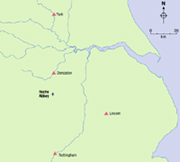 |
 |
 |
 |
 |
 |
 |
|
Roche Abbey holdings: urban properties (7/7) Whilst the monks sought seclusion, it was important and indeed necessary to secure urban properties so that members of the community had somewhere suitable to stay when travelling or on business. Roche had holdings in Doncaster, Lincoln, Nottingham and York. At Doncaster Roger of Flixborough held land of the abbot and monks for which he was to make an annual payment of 9s 4d and lodge any monks or lay-brothers of Roche – at their own expense - when they passed through the town.(12) The abbot had a house in Lincoln, a town that was at the forefront of commercial activity in the second half of twelfth century and was also accessible to trade. The house was worth 10s pa in 1275, but by the time of the Dissolution it had fallen in value to 4s. In York, another important centre of trade and commerce, Roche had land leading from the orchard belonging to the nunnery of St Clement to the River Ouse, for which they paid the prioress and nuns of St Clement £3. The monks also had a landing site at Flixborough, in Lincolnshire, for loading and unloading vessels; this lay between the North and South Stather, near the mouth of the Humber, which connected them with Hull and North Sea trade.(13) Traces of where the monks of Roche had holdings are still evident in the place-names. At Brancliffe grange, on the lane leading to the Sheffield and Worksop road, there is a bridge called ‘Monks’ bridge’, and a road at Little Todwick is called ‘Roche End’. |
